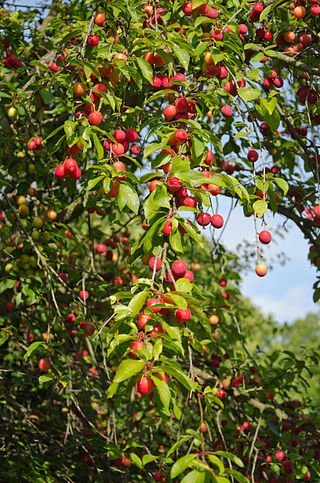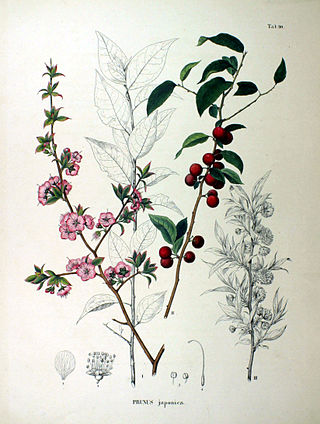
A cherry is the fruit of many plants of the genus Prunus, and is a fleshy drupe.

Prunus is a genus of trees and shrubs, which includes the fruits plums, cherries, peaches, nectarines, apricots, and almonds.

Forsythia, is a genus of flowering plants in the olive family Oleaceae. There are about 11 species, mostly native to eastern Asia, but one native to southeastern Europe. Forsythia – also one of the plant's common names – is named after William Forsyth.

Prunus laurocerasus, also known as cherry laurel, common laurel and sometimes English laurel in North America, is an evergreen species of cherry (Prunus), native to regions bordering the Black Sea in southwestern Asia and southeastern Europe, from Albania and Bulgaria east through Turkey to the Caucasus Mountains and northern Iran.

Prunus cerasifera is a species of plum known by the common names cherry plum and myrobalan plum. It is native to Southeast Europe and Western Asia, and is naturalised in the British Isles and scattered locations in North America. Also naturalized in parts of SE Australia where it is considered to be a mildly invasive weed of bushland near urban centers.

Prunus serrulata or Japanese cherry is a species of cherry tree that grows naturally in Japan, China, and Korea, and it also refers to a cultivar produced from Prunus speciosa, a cherry tree endemic in Japan. Historically, the Japanese have developed many cultivars by selective breeding of cherry trees, which are produced by the complicated crossing of several wild species, and they are used for ornamental purposes all over the world. Of these, the cultivars produced by complex interspecific hybrids based on the Oshima cherry are also known as the Cerasus Sato-zakura Group.

Prunus japonica, also called Japanese bush cherry, Oriental bush cherry, or Korean bush cherry is a shrub species in the genus Prunus that is widely cultivated for ornamental use. Its native range extends from Central China through to the Korean peninsula.

Weigela is a genus of between six and 38 species of deciduous shrubs in the family Caprifoliaceae, growing to 1–5 m (3–15′) tall. All are natives of eastern Asia. The genus is named after the German scientist Christian Ehrenfried Weigel.

Euonymus japonicus is a species of flowering plant in the family Celastraceae, native to Japan, Korea and China. It is an evergreen shrub or small tree growing to 2–8 m tall, with opposite, oval leaves 3–7 cm long with finely serrated margins. The flowers are inconspicuous, greenish-white, 5 mm diameter. In autumn, orange fruit hangs below the flaring pink seed coverings.

Euonymus fortunei, the spindle, Fortune's spindle, winter creeper or wintercreeper, is a species of flowering plant in the family Celastraceae, native to east Asia, including China, Korea, the Philippines and Japan. E. fortunei is highly invasive and damaging in the United States, causing the death of trees and forest in urban areas.

Prunus fruticosa, the European dwarf cherry, dwarf cherry, Mongolian cherry or steppe cherry is a deciduous, xerophytic, winter-hardy, cherry-bearing shrub. It is also called ground cherry and European ground cherry, but is not to be confused with plants in the distinct "Groundcherry" genus of Physalis.

Prunus sargentii, commonly known as Sargent's cherry or North Japanese hill cherry, is a species of cherry native to Japan, Korea, and Sakhalin (Russia).

Prunus avium, commonly called wild cherry, sweet cherry, gean, or bird cherry is a species of cherry, a flowering plant in the rose family, Rosaceae. It is native to Europe, Anatolia, Maghreb, and Western Asia, from the British Isles south to Morocco and Tunisia, north to the Trondheimsfjord region in Norway and east to the Caucasus and northern Iran, with a small isolated population in the western Himalaya. The species is widely cultivated in other regions and has become naturalized in North America and Australia.

Prunus glandulosa, called Chinese bush cherry, Chinese plum, and dwarf flowering almond, is a species of shrub tree native to China and long present in Japan. It is commonly used as an ornamental tree and for cut flowers.
Prunus apetala is a species of flowering cherry in the genus Prunus in the family Rosaceae. It is called clove cherry, because of its clovebud-shaped calyx. It is native to Japan, centered on the main island, Honshu.

Prunus davidiana is a species in the genus Prunus in the family Rosaceae. It is also known by the common names David's peach and Chinese wild peach. It is native to China, preferring to grow in forests and thickets, on slopes in mountain valleys, and in waste fields, from 800 to 3200 m. It is resistant to frost, and to a number of pests and diseases of cultivated peach, and is the subject of many studies for the genetic improvement of peaches.

Carex pumila, commonly known as strand sedge or spreading sedge, is a species of sedge of the family Cyperaceae.

Prunus pseudocerasus or Prunus pseudo-cerasus, the Chinese sour cherry or just Chinese cherry, is a species of cherry native to China and is used worldwide as an ornamental for its early spring cherry blossoms. The fruits of some cultivars are edible.

Hypericum patulum, known as goldencup St. John's wort or yellow mosqueta, is a species of flowering plant in Hypericumsect. Ascyreia.

Eriocapitella japonica is a species of flowering plant in the buttercup family Ranunculaceae. The specific epithet japonica means "from Japan", which is a misnomer since the species is introduced in Japan. It is native to China, Taiwan, and Vietnam.

























